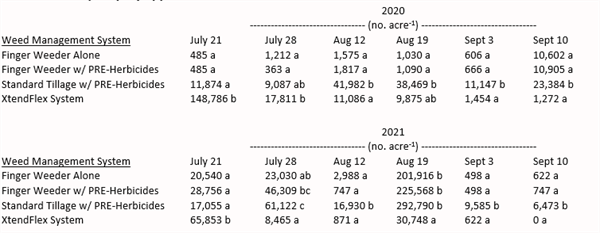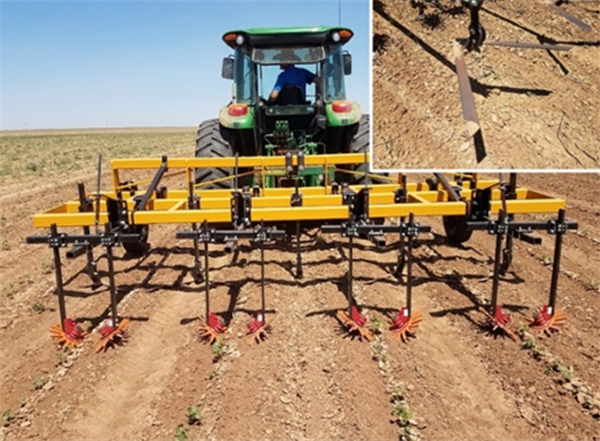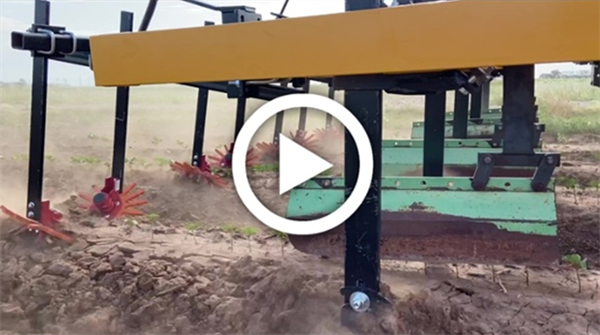Herbicide resistant Palmer amaranth is becoming increasingly problematic in Arizona cotton production. Cultivation is an effective way to control the pest, but standard cultivators do not remove in-row weeds. Finger weeders are an in-row weeding tool made from flexible rubber. Pairs are centered on the seed row and overlapped slightly to remove in-row weeds. In a two-year study, Dotray et al. (2021) evaluated the use of finger weeders for controlling in-row weeds in cotton at the Texas A&M research station in Lubbock, TX. In the study, a cultivator configuration developed by organic cotton grower Carl Pepper, Lubbock, TX was utilized. The device uses 34” wide, shallow pitched sweeps followed by finger weeders mounted on a spring-loaded arm (40” row spacing) (Fig. 1).
In the trials, use of finger weeders was compared to standard tillage, and an XtendFlex system where multiple herbicides were applied throughout the growing season (trifluralin – preplant incorporated; prometryn – preemergence; dicamba, S-metolachlor, glyphosate – early postemergence; dicamba, dimethenamid, and glyphosate second post emergence application). Six cultivations and two spray applications were made each year as dictated by weed pressure. Weed counts were recorded following cultivation and/or herbicide application on the dates indicated in Table 1. Hand weeding operations were performed twice during the season to control weed escapes.
The results were very promising. Control of Palmer amaranth with finger weeders was as good as chemical control using the XtendFlex system and significantly better than standard tillage. The authors also reported 95% in-row weed control when Palmer amaranth was ≤ 3 inches, and about 50% when plants were 3-4 inches tall. Crop injury due to cultivation was minimal, even in seedling cotton (1-3 leaf).
Some observations that are key to making the setup successful are that: 1) sweep blades are oriented such that the end of the sweep is pointed towards the crop row rather than away from it. This facilitates fracturing of soil toward the crop row making it easier for the finger weeders to loosen in-row soil and at a deeper depth, and 2) small diameter (9”) finger weeders made from relatively firm, yet flexible rubber are used and oriented at a steep angle. This configuration promotes soil penetration and loosening in firm soil.
A video of the device canhere or by clicking on the image below.
References
Dotray, P.A., Keeling, J.W., & Russell, K.R. 2021. Precision cultivation with finger weeder systems. Project No. 20-190 Final Report. Cary, N.C: Cotton Inc.
Acknowledgments
T
hanks are extended to Peter Dotray, Wayne Keeling and Kyle Russell, Texas A&M University for sharing their project findings. Credit and thanks are also extended to Kyle R. Russell, Texas A&M University, for recording and sharing images and video.
Project funding provided by Cotton Inc. Their support is greatly appreciated.
|
Table 1. Palmer amaranth population at various dates throughout the growing season following cultivation and/or spray application in 2020 and 2021. |


Fig. 1. Cultivator configuration used in Texas A&M studies investigating the use of finger weeders and wide sweeps to control in-row and between-row weeds in cotton. Cultivator design and setup credit: Carl Pepper, Lubbock, TX.

Fig. 2. Video of finger weeders and wide sweeps operating in seedling cotton to control in-row and between-row Palmer Amaranth. Video credit: Kyle R. Russel, Texas A&M University. Cultivator design and setup credit: Carl Pepper, Lubbock, TX. Click here to see the video.





